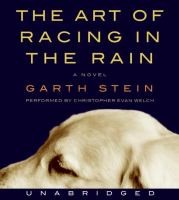Search the Blog
Categories
- Books & Reading
- Broadband Buzz
- Census
- Education & Training
- Friday Reads
- General
- Grants
- Information Resources
- Library Management
- Nebraska Center for the Book
- Nebraska Libraries on the Web
- Nebraska Memories
- Now hiring @ your library
- Preservation
- Pretty Sweet Tech
- Programming
- Public Library Boards of Trustees
- Public Relations
- Talking Book & Braille Service (TBBS)
- Technology
- Uncategorized
- What's Up Doc / Govdocs
- Youth Services
Archives
Subscribe
Tag Archives: Friday Reads
Friday Reads: Disrupted
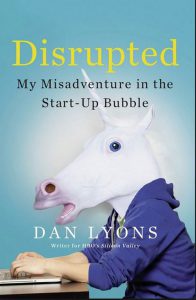 In Disrupted, Dan Lyons tells the story of his time working as a writer (mostly blogs) for the tech startup company HubSpot. Prior to working at HubSpot, Lyons had a number of writing gigs and most of them were technology related. His previous work included writing for Newsweek, New York Times Magazine, GQ, Vanity Fair, Wired, and writing the Secret Diary of Steve Jobs blog. When his position at Newsweek was eliminated, he found himself looking for work at the age of 50, while married with two kids to take care of (his wife had medical issues and was not working at the time). He started the search for new employment and eventually landed at HubSpot, a company that provides software for “inbound marketing.” Disrupted tells the story of Lyons searching for and then subsequently obtaining new employment (and the challenges that go with that) as an “older” adult (and with much younger colleagues), but also his general experience working within the unique tech environment. While not geographically Silicon Valley (HubSpot is located in Cambridge, Massachusetts) Lyons provides an apt description of an insider’s view from within a tech startup.
In Disrupted, Dan Lyons tells the story of his time working as a writer (mostly blogs) for the tech startup company HubSpot. Prior to working at HubSpot, Lyons had a number of writing gigs and most of them were technology related. His previous work included writing for Newsweek, New York Times Magazine, GQ, Vanity Fair, Wired, and writing the Secret Diary of Steve Jobs blog. When his position at Newsweek was eliminated, he found himself looking for work at the age of 50, while married with two kids to take care of (his wife had medical issues and was not working at the time). He started the search for new employment and eventually landed at HubSpot, a company that provides software for “inbound marketing.” Disrupted tells the story of Lyons searching for and then subsequently obtaining new employment (and the challenges that go with that) as an “older” adult (and with much younger colleagues), but also his general experience working within the unique tech environment. While not geographically Silicon Valley (HubSpot is located in Cambridge, Massachusetts) Lyons provides an apt description of an insider’s view from within a tech startup.
Lyons, albeit somewhat reluctantly, accepted the job at HubSpot for a few different reasons. For one, it was geographically close to home and his family. Secondly, he had a number of friends who reaped large financial benefits from working in tech startups (and had vouched that HubSpot was indeed legit), so there was a motivation of financial self interest. And thirdly, after writing about tech issues and companies for so long he was curious about experiencing the culture from an insider’s perspective. His experiences, as Disrupted details in often humorous and depressing fashion, were overall less than stellar. As he became immersed in the HubSpot culture, the realism of the organization he now was a part of settled in:
“This is the peppy, effervescent, relentlessly positive, incredibly hubristic and overconfident attitude that everyone in the HubSpot marketing department exudes from [the head] on down. These people are super cheery cheerleaders. The whole world of online sales and marketing is filled with people who listen to Tony Robbins audiobooks on their way to work and dream of unleashing the power within themselves, people who love schmaltzy, smarmy motivational-speaker guff about being passionate, following your dreams, and conquering fear.”
Lyons has now moved on from HubSpot, subsequently writing for HBO’s Silicon Valley (a gig he started while still at HubSpot). The thing that Lyons nails is his apt portrayal of the culture, including how these startups often don’t really make money, the lack of diversity (and apparent non-concern about it), sexism and ageism (Mark Zuckerberg once said that “Young people are just smarter”), and more concern with the fact that employees have bean bag chairs, ping pong tables, and unlimited supplies of beer, candy, and hype than actually producing a decent product that the average person understands. Lyons sums this up when mentioning the co-founders of Twitter (incidentally, Twitter hasn’t ever turned a profit), specifically Biz Stone, who has an estimated net worth of $200 million. Since leaving Twitter, Stone started two companies, Jelly and Super. As Lyons notes, no one understands what the companies actually do, including Stone himself:
“I know this is eye-rollingly, hallucinogenically optimistic…but our mission is to build software that fosters empathy.”
If you are interested in an insider’s view of tech startups, Disrupted is an easy and most entertaining read. If you liked HBO’s Silicon Valley, you would also like this book. And for the record, if you want to foster empathetic relationships, begin with your day to day interactions with real life human beings. Start with Hi. You don’t need software for that.
Friday Reads: Seneca Falls Inheritance
For this we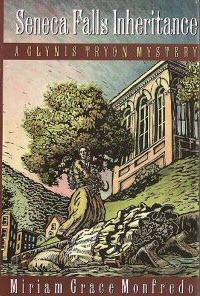 eks’ Friday Reads, I’ve decided to share a book related to my chosen craft, librarianship – Seneca Falls Inheritance, by Miriam Grace Monfredo.
eks’ Friday Reads, I’ve decided to share a book related to my chosen craft, librarianship – Seneca Falls Inheritance, by Miriam Grace Monfredo.
As a historian and former librarian, Monfredo definitely has the skills and knowledge to write a fun and clever historical murder mystery. The story takes place in 1848 in upstate New York State during the first Women’s Rights Convention, and is the first in a series featuring librarian Glynis Tryon.
The feminist in me loves this book for the independent Glynis, who has been asked by Elizabeth Cady Stanton to help organize the Women’s Rights Convention in Seneca Falls. The fact that Glynis is a librarian doesn’t hurt either. She’s a smart, stubborn, educated woman struggling to solve a woman’s murder in her small town. The New Yorker in me feels very much at home in Seneca Falls, a city I have actually visited myself.
I’ve re-read Seneca Falls Inheritance at least three times now, and I still find it both educational and entertaining. There are five more titles in this series, so once you’re hooked on Glynis and her adventures, there’s plenty more to read.
Friday Reads: Up to This Pointe by Jennifer Longo
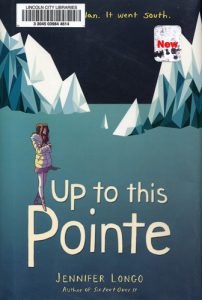 Harper (17) and her best friend Kate have held to the plan for their futures since sixth grade: to become ballerinas and share an apartment in their home city of San Francisco. Then things fall apart. Kate is on her way to their dream, Harper is not. Her body cannot do what Kate can do. With her dream lost, Harper goes to Antarctica to “winter over” for six months as a research assistant (and to patch herself back together). Told in alternating chapters of “Antarctica” and “San Francisco” the book slowly reveals what Harper should have seen coming but chose to ignore. Booklist says, “An adventure story with lots of heart.”
Harper (17) and her best friend Kate have held to the plan for their futures since sixth grade: to become ballerinas and share an apartment in their home city of San Francisco. Then things fall apart. Kate is on her way to their dream, Harper is not. Her body cannot do what Kate can do. With her dream lost, Harper goes to Antarctica to “winter over” for six months as a research assistant (and to patch herself back together). Told in alternating chapters of “Antarctica” and “San Francisco” the book slowly reveals what Harper should have seen coming but chose to ignore. Booklist says, “An adventure story with lots of heart.”
I found this book interesting because Harper knew little about Antarctica or the science studies connected with wintering over, but she lucked into a lesser assistant position. The reader learns about Antarctica and what Harper’s strong points are as Harper learns them (though a couple of times I did want to whack her upside the head). Still, people have to learn in their own time and way – and that does happen for Harper. I liked that Harper was good at her job, organizing the scientist’s notes and data. Ultimately she is generous to an unlikable member of the winter over team.
An unusual setting for a teen novel, it features two people who were dedicated to their futures and approached them with unfailing intensity and effort. To lose that would be devastating, and it does take Harper quite a while to move ahead.
Longo, Jennifer. Up to This Pointe. New York: Random House Books for Young Readers, 2016.
Friday Reads: Eligible by Curtis Sittenfeld
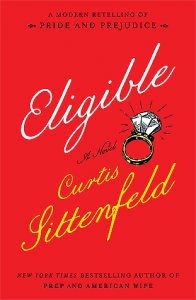 You may be familiar with Elizabeth Bennett and her sisters Jane, Mary, Kitty, and Lydia; their mother desperate to make them good matches, and their father smart enough to try to stay out of the way. But what if Liz Bennett was a magazine writer, Jane a yoga instructor, Mary focused on her online degree, Kitty and Lydia into CrossFit, and the family lived in Cincinnati circa 2013?
You may be familiar with Elizabeth Bennett and her sisters Jane, Mary, Kitty, and Lydia; their mother desperate to make them good matches, and their father smart enough to try to stay out of the way. But what if Liz Bennett was a magazine writer, Jane a yoga instructor, Mary focused on her online degree, Kitty and Lydia into CrossFit, and the family lived in Cincinnati circa 2013?
Meet Curtis Sittenfeld’s 21st century Bennett family. In this retelling, Liz and Jane have moved to New York City to pursue their careers, but the rest of the girls still live at home in Ohio, where Mr. and Mrs. Bennett belong to the local country club and ignore the decay of their Tudor home, their rapidly dwindling fortune, and the failing state of Mr. Bennett’s health. After their father ends up hospitalized, the older daughters return home, and Mrs. Bennett wastes no time in trying to set up one of her girls with reality television star-slash-ER-doctor Chip Bingley.
While a romance blossoms between Chip and Jane, Liz finds herself fending off advances from tech-whiz Cousin Willie and trying to save her family members from themselves. Enter neurosurgeon Fitzwilliam Darcy and…well, if you’ve read Pride and Prejudice, you already know how this one goes…
Sittenfeld, Curtis. Eligible. New York: Random House, 2016.
Friday Reads: The Reckoners (series)
Action! Adventure! Supervillains!
An unknown Calamity has caused certain people to develop all sorts of extraordinary superpowers. With their new abilities, these Epics have also become quite corrupted and seemingly invincible. Using their powers for destruction and control, the world has become fractured with people living under the Epics’ rule. The good guys are a small band of ordinary people called the Reckoners who are fighting back against the Epics with the help of Prof and his fantastic technology.
The series begins with our scrappy (and sometimes awkward) protagonist, David, in his obsessive quest to join the Reckoners and take down one of the most powerful Epics, Steelheart, who killed his father ten years earlier. Twists and turns move the story along very quickly as David and the Reckoners face the war that they’re about to start.
In all of his writing, Brandon Sanderson’s world-building and magic (or superpower) systems are incredible. He’s a favorite. I haven’t listened to any of the audiobook versions, but according to other reviews, MacLeod Andrews does a wonderful job with narration.
- Steelheart #1 (September 2013)
- Mitosis #1.5, short story (December 2013)
- Firefight #2 (January 2015)
- Calamity #3 (February 2016)
[youtube https://www.youtube.com/watch?v=6sC9NtpXLH4?rel=0]
Random House Kids. (2013, September 5). Steelheart by Brandon Sanderson. [Video file]. Retrieved from https://youtu.be/6sC9NtpXLH4
Friday Reads: The Fold, by Peter Clines
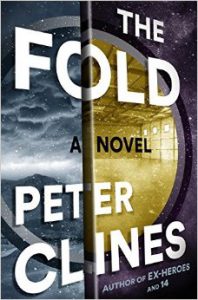 They tried to create a teleportation machine (a transporter, if you’re familiar with Star Trek), but after much study, came to the realization the present technology can’t support the theory. So they moved the project and attempted a different approach. This team of DARPA (Defense Advanced Research Projects Agency) scientists in the California desert who believe they have created a portal that “folds” dimensions so a traveler may move hundreds of miles with one step. At budget time the agencies involved aren’t getting the information they believe they should. And even the head of their project in Washington is getting some odd vibes from the group, so he sends his own form of investigative team in to check on everything. A high school English teacher, Leland “Mike” Erikson, who looks like Servius Snape, college edition.
They tried to create a teleportation machine (a transporter, if you’re familiar with Star Trek), but after much study, came to the realization the present technology can’t support the theory. So they moved the project and attempted a different approach. This team of DARPA (Defense Advanced Research Projects Agency) scientists in the California desert who believe they have created a portal that “folds” dimensions so a traveler may move hundreds of miles with one step. At budget time the agencies involved aren’t getting the information they believe they should. And even the head of their project in Washington is getting some odd vibes from the group, so he sends his own form of investigative team in to check on everything. A high school English teacher, Leland “Mike” Erikson, who looks like Servius Snape, college edition.
Mike, as he prefers to be known, had an eidetic memory, and an extremely high IQ. The combination makes him a perfect fit for the Sherlock Holmes role. Mike is interesting, and the way he handles his memory makes the concept approachable. It also adds an interesting dimension to some of the things we take for granted, like forgetting painful experiences, and the immediacy of grief.
And yet, even for Mike, it’s hard to see what’s wrong with the Albuquerque Door, as they’ve named this machine that fold space. There have been nearly 400 human tests, without an injury. “Nine people, two hundred and sixteen rats, six cats, and a chimpanzee,” (p.49) have been through the door, and not one lost. And yet all the scientists, engineers, and programmers, who have been the test subjects are uneasy, and want to continue to do tests. Until something does go wrong. Of course, it goes so badly wrong that everyone is stunned, and someone dies. This group is small, again, just six people, who outsource for medical or any other services.
Oh, yes the secret comes out, and the situation goes downhill fast. This becomes on of those Nantucket sleigh rides, and with very interesting twists. Just as you think you understand what’s going on, Mr. Clines throws you a curve, some from left field. And in the end, some logic, luck, and fast thinking saves the day. Just not neatly, cleanly, and with some odds and ends.
It is definitely an adult work of Science Fiction, Fantasy/Horror, some parts are not for the squeamish, and it is thriller territory. But it is a fun, and satisfying read, with quips, humor, and interesting characters.
Friday Reads: The Disaster Artist, by Greg Sestero & Tom Bissell
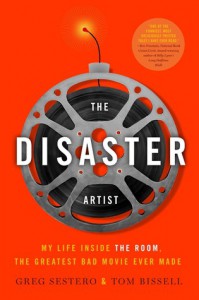 No one would seek out a bad meal. If you heard a friend rant about an awful vacation, you wouldn’t check prices for the next flight there. But art is different: it can entertain and stimulate even when it fails to accomplish its goals. Sometimes especially when it fails. “Bad art” is not always bad—under the right conditions, it can be sublime. And if it’s entertaining, is it really bad?
No one would seek out a bad meal. If you heard a friend rant about an awful vacation, you wouldn’t check prices for the next flight there. But art is different: it can entertain and stimulate even when it fails to accomplish its goals. Sometimes especially when it fails. “Bad art” is not always bad—under the right conditions, it can be sublime. And if it’s entertaining, is it really bad?
The Room has been called “the Citizen Kane of bad movies”. Written and directed by Tommy Wiseau, a shadowy character of unknown origin, the film is essentially a tragic love triangle involving a banker, his unfaithful fiancée, and the banker’s best friend. It seems to be standard fare, but The Room delivers this routine story through a narrative that’s full of quickly-dropped disease and drug subplots, continuity errors, and astonishingly incoherent dialogue (“You don’t understand anything, man! Leave your stupid comments in your pocket!”). If aliens who had never interacted with humans tried to stage an episode of Melrose Place, it would feel like The Room. One early review described it as “like getting stabbed in the head.” Some films leave you with questions about existence, ethics, art—the first question that comes to mind after viewing The Room is “how could this happen?”
This book explains how. Some things are outlined in more detail than others, as Sestero respects Wiseau’s famous reluctance to discuss his past. In fact, the book’s strongest moments capture the friendship between Sestero and Wiseau. I was concerned that The Disaster Artist would be full of jabs at Wiseau’s hubris and that sometimes happens, but the book generally presents him as a sometimes kind and warm, if very naïve and very, very strange, person. It’s rather analogous to the Tim Burton biopic about Ed Wood in its loving treatment of an outsider. And it’s surprisingly well-written, given that it’s ostensibly a book about a baffling cult film. The narrative is split between Sestero’s real life adventures with Wiseau and a day-by-day account of the film’s production, but its back-and-forth structure never becomes confusing. Unlike The Room itself.
It’s the perfect time to see The Room and read this book, as there are two related films set to be released this year—a mockumentary starring most of the original cast and a posh studio adaptation of The Disaster Artist featuring Bryan Cranston and Sharon Stone, among others. You will probably never surpass me in terms of Room fandom (so don’t worry), but you will be ahead of the curve if 2016 turns out to be a year of Room fever. And you will also know all about the flying vampire car that didn’t make into the final version of the film. Yes, really.
In my opinion, a bad film is a boring film (oh, hi, The English Patient). The Room and its brethren (like Troll II and Dunyayi Kurtaran Adam) are endlessly entertaining and rewatchable. The Disaster Artist captures the energy and atmosphere that make these films unique. They’re surreal and special. Not bad.
Sestero, G., & Bissell, T. The disaster artist: My life inside The Room, the greatest bad movie ever made.
Friday Reads: The Fishermen, by Chigozie Obioma
 Chigozie Obioma’s book, The Fishermen, is one of those novels that’s perfect for book groups or for individual reading, because you can feel through it, or think through it, or both. This compelling page-turner has characters that the reader will be emotionally invested in, but it’s also a novel that’s good for discussion for groups who want to take more time with the unpacking. It’s a good recommendation for the reader wanting a straightforward narrative, as well as the reader looking for symbolism, mythic undertones, and classic themes, all written with a fresh voice.
Chigozie Obioma’s book, The Fishermen, is one of those novels that’s perfect for book groups or for individual reading, because you can feel through it, or think through it, or both. This compelling page-turner has characters that the reader will be emotionally invested in, but it’s also a novel that’s good for discussion for groups who want to take more time with the unpacking. It’s a good recommendation for the reader wanting a straightforward narrative, as well as the reader looking for symbolism, mythic undertones, and classic themes, all written with a fresh voice.
The story is set in 1990s Nigeria, and our narrator is Benjamin, one of four young brothers in a loving family. When their father’s job takes him to another city away from the family home, the brothers must navigate growing up and being young, with each other as role models. Their relationship with their mother is strong, and tender, but they want to grow up as much as they want her acceptance and affection. After a man in their town makes a prediction about their future, their love is tested—and there is a battle of wills, within and among the brothers, to see if the prophecy can be ignored.
Because the story is from a child’s point of view, you don’t need have any previous knowledge about Nigeria or the 1990s in order to enjoy the book. Some details of the story might inspire you to do more research, but all the reader needs to know is in the book. The author includes a few words of the vernacular languages, but the meanings of those words are clear from the context. The themes of the story would work whether the setting was Nigeria or Nebraska: how much we can love and despise our siblings, how mistakes made by the people we look up to can shake our security in the world, and how the sacrifices parents make for their children are often misunderstood by those children.
The Fishermen was shortlisted for the 2015 Man Booker Prize for Fiction, and received glowing reviews from the New York Times, here; and The Guardian, here; and from many other publications. The author is currently living in the United States and teaching at the University of Nebraska.
Friday Reads: A Week in Winter, by Maeve Binchy
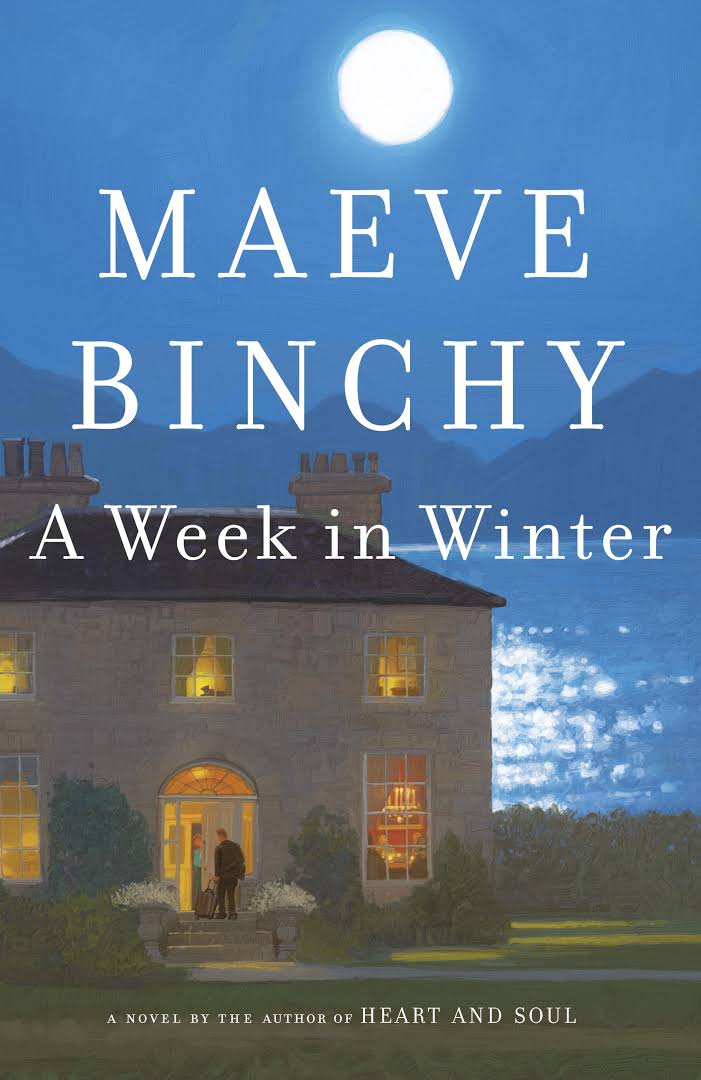
Talk about “johnny-come-lately,” just last week I picked up a paperback copy of this title at a used-book sale at Greenwood Public Library. I had gone there on a trip back from Papillion to see the renovation completed in Greenwood, partly with money from the Kreutz Bennett Donor Advised Fund. I’d been meaning to read something by Maeve Binchy for years but hadn’t, fascinated as much by her name as anything. I’m sure Binchy fans are probably appalled that I’d waited so long. Now, as it turns out, this title is the very last one she wrote; she died shortly after finishing this book.
A Week in Winter tells the charming story (actually many stories) of a host of eventual guests at Stone House, a new guest house located in what had been a run-down mansion on the west coast of Ireland, high overlooking the Atlantic Ocean. Three elderly sisters, had lived a “beans-and-toast” existence there, with Queenie the only survivor. The proprietress of this venture is a former resident of Stoneybridge, the town in which the place is located. She has returned from a long stay in the States with some money to invest in her hometown. Her story is that she is returning following the death of her spouse in a car wreck. As with many of the characters in this story, however, her biography is not quite as presented to the world.
A cast of characters descends upon Stone House during its first week in business, from many venues – the U.S., Sweden, England, Ireland (of course), and so forth. The author sets the scene with each one coming to this “restful place for a holiday by the sea” for quite different reasons. One guest couple wins second place in a travel contest (and they’re not happy about not going to Paris instead). One of the staff is sent there following a reform school stint. Another guest arrives following a devastating affair. (She’s the librarian!) Another received her stay as a retirement gift from teaching. (She is probably the only character who is not rejuvenated by her stay.) Still another — the one from Sweden – is faced with taking over his father’s button-down business, while he’d rather be playing music in local Irish pubs.
My guess is that Binchy fans will love this book. It felt to me a bit like what one of the characters says: “Problems don’t solve themselves neatly like that, due to a set of coincidences.” It does appear that the circumstances in which each character finds herself or himself are too easily “wrapped up” in the story. However, the author is such a good writer that I think I’ll try at least one more title. Any suggestions out there about which of her other nineteen titles is worth a go?
Friday Reads : The House Girl
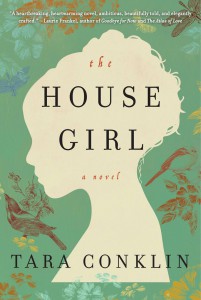
From Amazon:
“The House Girl, the historical fiction debut by Tara Conklin, is an unforgettable story of love, history, and a search for justice, set in modern-day New York and 1852 Virginia.?
Conklin’s use of alternating chapters weaves together “the story of an escaped slave in pre–Civil War Virginia, and a determined junior lawyer in present-day New York City. The House Girl follows Lina Sparrow as she looks for an appropriate lead plaintiff in a lawsuit seeking compensation for families of slaves. In her research, she learns about Lu Anne Bell, a renowned prewar artist whose famous works might have actually been painted by her slave, Josephine.” While retracing Josephine’s often-elusive path, she also uncovers some troubling facts about her own life and parents, and the startling lie that formed the basis of her childhood and young adulthood.
I started listening to The House Girl on audio, then was so caught up by the story, that I checked out the book from Lincoln City Libraries. Definitely a good read!
Posted in Books & Reading, General, Information Resources, Programming, Uncategorized
Tagged Friday Reads
Leave a comment
Friday Reads: Notorious RBG: The Life and Times of Ruth Bader Ginsburg, by Irin Carmon and Shana Knizhnik
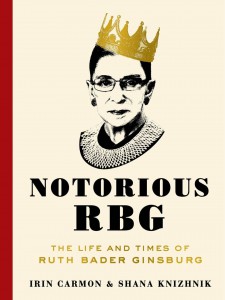 This book came to my attention after I listened to Debra Winger read My Life on the Road by Gloria Steinem. The death of Justice Antonin Scalia precipitated selecting this title from my queue since Ginsburg and Scalia were known to have been fast friends despite their ideological differences. I am ashamed to confess how wholly unaware I was of the tremendous gender inequity around me as a younger woman. Like watching episodes of Mad Men it is an all too visceral reminder of just how far we’ve come and how much we’ve yet to accomplish.
This book came to my attention after I listened to Debra Winger read My Life on the Road by Gloria Steinem. The death of Justice Antonin Scalia precipitated selecting this title from my queue since Ginsburg and Scalia were known to have been fast friends despite their ideological differences. I am ashamed to confess how wholly unaware I was of the tremendous gender inequity around me as a younger woman. Like watching episodes of Mad Men it is an all too visceral reminder of just how far we’ve come and how much we’ve yet to accomplish.
One reviewer wrote “her appointment to the Court by Bill Clinton will be seen as one of his greatest accomplishments” and I’m inclined to agree. Her quiet and pragmatic work on issues of equity and equality have made the world a little better and a little freer. Her uncanny ability to know which cases were ready to go forward and those that were not is helpful to think about as I examine current issues being debated in state legislative houses.
Learning about RBG’s marriage was a revelation of both envy and delight. I’ve always admired those kinds of partnerships and this book made me appreciate Marty as much as Ruth. Supporting Ruth and her career was his proudest accomplishment. It reminded me of Paul and Julia Child’s marriage.
The life of Ruth Bader Ginsburg is one worth knowing and one easily presented in this quick read. I don’t believe this book is meant to be a definitive biography of RBG but it is a tremendous introduction.
Friday Reads: “Yoga: The Path to Holistic Health,” by B.K.S. Iyengar,
 If you know me, you will not be surprised to hear that I’m obsessed with a book about yoga. The thing is, it’s not just a book about yoga; it is THE book about yoga. I’ve borrowed it from (several) libraries dozens of times, bought it for myself and others, and talked about this book to so many people that, frankly, people are starting to drift away at cocktail parties when I bring it up. But since I assume that most of the readers of this post are librarians, I’ll continue on.
If you know me, you will not be surprised to hear that I’m obsessed with a book about yoga. The thing is, it’s not just a book about yoga; it is THE book about yoga. I’ve borrowed it from (several) libraries dozens of times, bought it for myself and others, and talked about this book to so many people that, frankly, people are starting to drift away at cocktail parties when I bring it up. But since I assume that most of the readers of this post are librarians, I’ll continue on.
If you’ve appreciated the proliferation of yoga classes in contemporary culture, you might have this author to thank for it. Bellur Krishnamachar Sundararaja (B.K.S.) Iyengar is considered the father of modern yoga and the teacher that opened the door to yoga to the Western world. Called “Guruji” by millions of devoted followers, he was honored with a Google doodle showing him in yoga poses last year on what would have been his 97th birthday to celebrate his practicing, teaching and writing about yoga for more than seventy-five years. It has been said that B.K.S. Iyengar could hold a headstand for nearly half an hour well into his eighties. He died in 2014 at the age of 95.
This book provides concise information on the history and philosophy of yoga, but the bulk of the book is devoted to photos and text on how to practice the classic yoga postures (asanas). The book promises: “Yoga is for everyone. You do not need to be an expert or at the peak of physical fitness to practice the asanas described in this book…This book focuses on techniques, so that even a beginner will have a thorough understanding of how to practice the asanas in order to obtain the maximum benefit. By using a few simple props, students with different capabilities can gradually build up strength, confidence, and flexibility without the threat of strain or injury.” And it delivers on this promise with step-by-step instruction on each asana, featuring photos from different angles. The instruction stresses proper alignment and breathing, with variations from beginner to advanced practitioner. The section on Yoga Therapy offers specific asanas to treat specific ailments by rejuvenating the body and then addressing the cause of the ailment. I can attest to the fact that I have come to the mat with a backache and left without it, but the book stresses the importance of steady, consistent, sequential practice—no quick fixes here.
Whether you only have one book on yoga in your collection, or dozens, Yoga: The Path to Holistic Health, by B.K.S. Iyengar, is one you’ll want to review. And the best way to review it is to try it out on the mat. Namaste…mjr
PS: If you wonder why I have had to borrow it from several libraries, it’s heavy (large format, 400+ pages, 4.2 pounds) and I don’t take it with me when I travel—but I can’t seem to go more than a few sessions on the mat without referring to it. So wherever I travel, I have to have it. Thank you public libraries across the country for loaning me this great book.
Friday Reads: Tell the Wolves I’m Home, by Carol Rifka Brunt
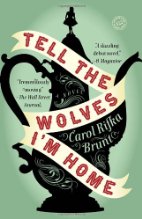 I think my colleagues will be glad that I’m finished with this book, as I’ve been an emotional wreck every afternoon after listening to another installment over my lunch hour. The story is set in 1987, in and around New York City, at the height of the AIDS epidemic. Several chapters in, 14-year-old June Elbus’s beloved uncle and godfather, Finn, dies of the disease. Fractures between June and her 16-year-old sister, Greta, which began prior to Finn’s death, open further, leaving each alone with her unique pain. And June’s mother, Finn’s sister, is so caught up in her own grief and resentment that she doesn’t see how her personal issues have contributed to her daughters’ crises.
I think my colleagues will be glad that I’m finished with this book, as I’ve been an emotional wreck every afternoon after listening to another installment over my lunch hour. The story is set in 1987, in and around New York City, at the height of the AIDS epidemic. Several chapters in, 14-year-old June Elbus’s beloved uncle and godfather, Finn, dies of the disease. Fractures between June and her 16-year-old sister, Greta, which began prior to Finn’s death, open further, leaving each alone with her unique pain. And June’s mother, Finn’s sister, is so caught up in her own grief and resentment that she doesn’t see how her personal issues have contributed to her daughters’ crises.
A major catalyst for the emotional drama of the story is the secret June’s mother forced Finn to keep from June as a condition of him being allowed to be a part of her life: the very existence of his beloved partner Toby, with whom he shared his apartment and life. June learns of Toby’s existence at Finn’s funeral, when her mother spots him outside the funeral parlor, and her father tells June and Greta to alert him if “that man” tries to enter the building.
Several weeks after the funeral, Toby contacts June with a gift from Finn and a request to meet secretly, as she is, according to his note, “perhaps the only person who misses Finn as much as I do…” Thus begins a tentative and covert friendship, orchestrated in part, we find out, by Finn, which brings both comfort and additional pain to June.
What totally guts me about this book is the degree to which pain begets pain, especially between people who love each other. Greta’s pain, an outgrowth of her growing estrangement from June, along with pressure from her mother to not pass up any opportunities, even those she’s not ready for, leads her to cruelly and repeatedly lash out at June – behavior that, counterproductively, just causes more pain and further estrangement.
Similarly, the pain June and Greta’s mother holds on to from her own past – the abandonment she felt when Finn left home at seventeen; her jealousy and regret over the fact that he became the famous artist in New York City, while she wound up an accountant in the suburbs – leads to her irrational ultimatum about Toby, and its cascade of consequences. Her goal may have been to hurt Toby and teach Finn he “couldn’t have everything,” but her daughter June suffers significant collateral damage. Disoriented upon learning how much she didn’t know about Finn, June questions the very foundation of their relationship – essentially losing him twice. And even though she gets some of Finn back through Toby, she struggles with feelings of humiliation at having thought herself the most important person in Finn’s life at a time when everyone else knew he had Toby.
While this book doesn’t come with a “happily ever after” ending, it does suggest that, moving forward, there is hope for redemption and reconciliation for June, Greta, and their mother. Perhaps more significantly, it serves as a powerful reminder to those of us muddling through the mess of our own lives to resist acting out of pain and instead choose love.
Brunt, Carol Rifka. Tell the Wolves I’m Home. New York: Dial Press, 2012.
Friday Reads: The Girl in the Spider’s Web, by David Lagercrantz
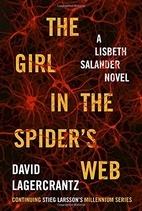 As a fan of Stieg Larsson’s Millennium series I was curious to find whether David Lagercrantz’s The Girl in the Spider’s Web would be a worthy continuation of Larsson’s work. Labeled as the fourth book in the series, Lagercrantz, in my view, extended the series with notable success. While a number of readers have posted comments that the book doesn’t have the suspense of Larsson’s books, among other things, I wasn’t disappointed in this one.
As a fan of Stieg Larsson’s Millennium series I was curious to find whether David Lagercrantz’s The Girl in the Spider’s Web would be a worthy continuation of Larsson’s work. Labeled as the fourth book in the series, Lagercrantz, in my view, extended the series with notable success. While a number of readers have posted comments that the book doesn’t have the suspense of Larsson’s books, among other things, I wasn’t disappointed in this one.
The Girl in the Spider’s Web includes a mix of high level intellectual property theft, corruption, Lisbeth Salander’s evil twin sister, a Mikael Blomkvist perceived as a no longer revered investigative reporter, a rogue National Security Agency security chief, the usual police suspects, and an autistic child with a genius for math and drawing. Add in a number of familiar characters from Larsson’s earlier works plus several new ones, and plenty of bad guys. Most interesting is always the girl – Lisbeth Salander – a legend among hackers, fearless, clever, fiercely independent, and unhinged.
I borrowed both hard copy and the audiobook from Lincoln City Libraries. Now I’m ready for the movie. Noomi Rapace or Rooney Mara?
Lagercrantz, David, and George Goulding. The girl in the spider’s web. (New York: Alfred A. Knopf). 2015.
Friday Reads: The Art of Racing in the Rain, by Garth Stein
I have had this on my list for a while. Since I am not a dog person, nor a car person, I overlooked it until now. I have already recommended it to friends of the 2-legged variety (dog-owning, car-driving or otherwise) because it isn’t a dog story or a car story…it’s a life story.
Enzo, a Lab-Shepherd-Doodle mix and the narrator of the story, would agree he is man’s best friend. When up-and-coming racecar driver Dennis brings him home as a puppy, their friendship and Enzo’s life lessons begins. As the mostly silent partner in the relationship, we are taken inside Enzo’s head to analyze the action taking place as Denny meets and marries his wife, Eve, and they add little Zoe and they struggle with the curves in their road of life. As the old boy ages, he looks back in this memoir of a 4-legged friend who is more compassionate then some humans, understands more than you realize, and looks forward to a applying the lessons he learned in a future life as a man.
“Here’s why I will be a good person. Because I listen. I cannot talk, so
I listen very well. I never deflect the course of the conversation with a
comment of my own. People, if you pay attention to them, change the
direction of one another’s conversations constantly. It’s like being a
passenger in your car who suddenly grabs the steering wheel and turns
you down a side street…”
Enzo’s listens and learns from all his humans as well as the television, which Denny leaves on for him during the day. All this information will help prepare himself for his next life on two legs. As Denny shares his successes or losses on the track, and they review race video, his dog learns how the art of racing and navigating life lessons overlap. Humor of life as a dog is interwoven with these because, of course, a dog can’t know everything and be everywhere. The author cleverly inserts that fact into Enzo’s stream of consciousness as he tries to share with us what he has pieced together about life and about the story’s action involving his family for which he wasn’t allowed to be present.
I am an audiobook reader and have recently discovered the art of downloadable collections from my local library. One of the reasons I enjoyed this book so much was hearing Enzo “speak,” given voice by actor Christopher Evan Welch (1965-2013); you are just listening to a friend share his trials and tribulations. I hope you will love it as much as I did, and maybe you will learn some lessons along the way that you can apply in your next life—as a dog.
PS—Garth Stein, the author, has also adapted this for youth under the title Racing in the Rain.
Friday Reads: Carsick by John Waters
“It wasn’t until I started reading and found books they wouldn’t let us read in school that I discovered you could be insane and happy and have a good life without being like everybody else.”
― John Waters
Let’s just say right off the top, if you’ve already heard of John Waters and have seen and didn’t care for his movies, you probably will not like this book. If you weren’t offended by his films (Ok, if you might have been just a bit moderately offended but not totally disgusted to the point that you could no longer watch), this book could be right up your alley. For me, it certainly was! I loved it, laughing harder than I have in months. Maybe even years! Crammed full of carnival oddities, raw direct adult language, filth (both general and specific), the grotesque, and other assorted deviances, this book is definitely not for the squeamish. Consisting of various explicit stories told in the most humorous of fashions, the basic premise is that Waters (often called the Pope of Trash or the People’s Pervert) hitchhikes from his home in Baltimore to his second home in San Francisco and then details his experience on the road. The first two parts of the book are fiction and are told in a fashion very Waters-esque, living up to his aforementioned unofficial titles. Part one is a chronicle of what his journey across the country would be like from a best case scenario perspective; part two from a worst case perspective. The final third of the book details what actually happened in his hitchhike across the country. We salute and thank you, John Waters (and my local library for including this book in the collection), for feeding the soul of the low brow reader.
Friday Reads: The Library of Shadows
I discovered The Library of Shadows, by Mikkel Birkegaard, while browsing the shelves of a Borders store that was having a Going Out of Business sale. Of course, it caught my eye because of the word Library in the title. And the cover looked kind of supernatural, which definitely made it even more attractive to me. I wasn’t completely sure about it though, when I saw that it was translated from the Danish. But, I’m glad I picked it up, because it ended up being a really good story!
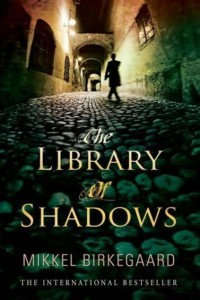 As it turns out, there are people in the world who, when they read books aloud, can control how others feel and think – manipulating listeners and immersing them completely into the story. They are called Transmitters. On the other side, there are also people who can connect with a Transmitter, called Receivers. They can focus the energy of a Transmitter, enhancing their storytelling ability, making the effect of their reading even stronger. Together, they are part of a secret society who’s original goal was to help people develop a better enjoyment and understanding of literature. But, as happens with powers like these, there are other factions who have used these abilities for nefarious purposes.
As it turns out, there are people in the world who, when they read books aloud, can control how others feel and think – manipulating listeners and immersing them completely into the story. They are called Transmitters. On the other side, there are also people who can connect with a Transmitter, called Receivers. They can focus the energy of a Transmitter, enhancing their storytelling ability, making the effect of their reading even stronger. Together, they are part of a secret society who’s original goal was to help people develop a better enjoyment and understanding of literature. But, as happens with powers like these, there are other factions who have used these abilities for nefarious purposes.
As you read the book, you are discovering this strange new world along with Jon Campelli, who has inherited a bookshop from his father, which just happens to be a secret gathering place for people with these talents. Jon’s father has most likely been murdered and then the shop is fire bombed, forcing him to explore this mysterious society as he tries to solve his father’s murder and find out what the shadowy group who committed these crimes is really up to.
Since Jon knows just as much as you do about these people, meaning absolutely nothing, a reader can easily identify with him and understand his confusion and awe as he learns more about them. It’s a very original story concept, at least I’ve never heard of anything like this. In between the fast-paced action scenes, and many cliffhanger chapter endings, the history and workings of this ancient organization are very well developed. If you are a fan of mysteries, magic, and reading, I think you’ll enjoy this one.
Friday Reads: Fatal Fever: Tracking Down Typhoid Mary, by Gail Jarrow
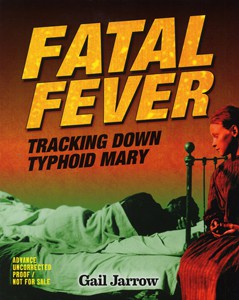 As a child I first heard the term “Typhoid Mary” as a term, not a person, and did not think much more about it until I read Fatal Fever: Tracking Down Typhoid Mary by Gail Jarrow. The author provides clear and concise information about the disease and how it is spread. She then focuses on Mary Mallon and the effort that went into identifying and locating her.
As a child I first heard the term “Typhoid Mary” as a term, not a person, and did not think much more about it until I read Fatal Fever: Tracking Down Typhoid Mary by Gail Jarrow. The author provides clear and concise information about the disease and how it is spread. She then focuses on Mary Mallon and the effort that went into identifying and locating her.
The author gives a brief history of typhoid fever, noting that is has been around since prehistoric times. Then she brings the reader to January of 1903 in Ithaca, New York, where typhoid fever infected a number of local citizens as well as Cornell University students. The author tells of the disease, how it was transmitted, and efforts to reduce the possibility of contracting it. The New York State Commissioner of Health contacted George Soper, a sanitary engineer, who had helped Galveston, Texas deal with sanitation issues and disease following a deadly hurricane. The clean-up of the wells, cesspools and outhouses in Ithaca, along with the installation of a filtration system took several months.
Determined to prevent future outbreaks Soper was soon on the trail of one individual he felt was responsible for spreading the disease in 1906 and beyond. His efforts, along with assistance from others, and Mary Mallon’s viewpoint that she was being harassed for no reason, are documented throughout the rest of the book. Mary continued to assert she had never contracted typhoid fever and thus could not infect others. Mr. Soper insisted that she must have had a light case that was not diagnosed and continued to carry the disease, his opinion eventually being verified after she was detained and tested.
This account reads like a detective novel and a tragedy. One person feeling persecuted and other people suffering from a terrible disease. Reading this put in my mind a real person who was appalled when the name “Typhoid Mary” first appeared in the newspaper. She had always been honest and worked hard and couldn’t understand why people were so convinced she was spreading disease.
The book includes period photographs, posters, cartoons, and newspaper items that convey the living conditions of the time and the suggestions for avoiding disease. Source notes, a bibliography, and an index are also included.
Friday Reads: How Music Got Free: The End of an Industry, the Turn of the Century, and the Patient Zero of Piracy, by Stephen Witt
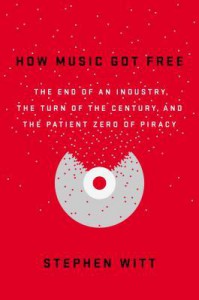 How do you listen to music nowadays? Do you still buy CDs? (…did you ever buy CDs? I might be showing my age here…), download digital files, use a streaming service online? Did you ever wonder how exactly we got from the “good old days” of recording mixed tapes to having any song available at our fingertips? How Music Got Free: The End of an Industry, the Turn of the Century, and the Patient Zero of Piracy by Stephen Witt answers this question and more. From the invention of the MP3 format to the role of the music industury executives in the demise of their own business, this is a fascinating history of an industry turned on its head. Witt focuses on 3 individuals who couldn’t be more different, yet who each played a crucial role in changing how we access music.
How do you listen to music nowadays? Do you still buy CDs? (…did you ever buy CDs? I might be showing my age here…), download digital files, use a streaming service online? Did you ever wonder how exactly we got from the “good old days” of recording mixed tapes to having any song available at our fingertips? How Music Got Free: The End of an Industry, the Turn of the Century, and the Patient Zero of Piracy by Stephen Witt answers this question and more. From the invention of the MP3 format to the role of the music industury executives in the demise of their own business, this is a fascinating history of an industry turned on its head. Witt focuses on 3 individuals who couldn’t be more different, yet who each played a crucial role in changing how we access music.In Germany, an audio engineer, Karlheinz Brandenburg, and his team developed the MPEG3 data compression format and fought for its acceptance over rival formats, a largely political battle. When not adopted by the industry, the team released the MP3 format to the public as a free conversion tool and music player.
In North Carolina, Dell Glover was using his job at a CD manufacturing plant to become the leading music leaker in an elite online community. What had been a tedious task of burning individual cds to sell from the trunk of his car on weekends became vastly simplified with the introduction of the MP3 format and the ability to upload music easily and quickly to the internet. (Mr. Witt also published this piece about Dell Glover in the New Yorker in April 2015.)
In New York, Doug Morris, the CEO of Universal Music Group, was too concerned with signing the next big rap artist to pay much mind to the growing portable music revolution. Morris and other executives failed to grasp the significance of the MP3 format (and the piracy it enabled), leading eventually to a litigative nightmare and the downfall of the music industry as we knew it.
Whether or not you were online in the heyday of Napster, this book tells a compelling tale about a fascinating part of our recent history.
Friday Reads: Updraft by Fran Wilde
 This book is a first for the author, who is known by her short stories, according to the book blurb. This tale, is one of redemption in a postapocalyptic world set far, far in the future, of, I would guess, Earth, since there are familiar species of birds. But it’s the juxtaposition of the familiar birds with the strange that makes it so compelling.
This book is a first for the author, who is known by her short stories, according to the book blurb. This tale, is one of redemption in a postapocalyptic world set far, far in the future, of, I would guess, Earth, since there are familiar species of birds. But it’s the juxtaposition of the familiar birds with the strange that makes it so compelling.
Humans live in towers of living bone, the higher in the tower, the higher your social status, and as the towers grow, the lower levels are abandoned, since they get more crowded by the growth of the bone. Travel between the towers is allowed, and is accomplished by flying with one’s own set of wings, which one is tested for at a certain, young age. Travel inside the towers is accomplished by ladders. But the outcasts of the culture are also left in the lower levels of the tower to live or die. It is a very rule orientated way of living, where the main character, Kirit, longs to be a trader, like her mother, attain the right to fly to other towers and trade and also bring medicine. She is close to earning the right to fly free, as well as earn her apprenticeship as the story opens, when she and her once closest friend Nat, break the Tabu/Law, she goes outside during an attack, and he doesn’t let her back in. So they are equally at fault, and get caught by one of their officers, called a Singer. But in being caught outside, Kirit displays a unique skill that the Singers need. But the skill gets in the way of her dreams.
In another story, she might have simply gone with the authority figure, but not this one. She and Nat both work to get through their punishment in time for both to take their flight tests. To get done in time they meet and receive help from one of the cast off citizens of the towers, Tobiat, old, with injuries badly set and healed, and mind a little scattered. He turns out to be key to many of the mysteries come to face. The tests seem to be passed, but the Singers have skewed them, and both Kirit has to go with them to their tower. She learns secrets that turn many of the things she’s learned in the towers inside out, and finds that the strange creatures that attack their towers were once much different. Not only does so much she has learned about her family change, but also about her culture.
So much happens in such a short pace of time. But it changes so many lives of this small civilization on the edge of survival. The disruption spreads from one life, to a family, to an order keeping service type organization. It’s interesting to see, after reading the book, how the character of one actor, can serve as a catalyst to expose the wrongdoing of an entire organization.
Reviews
Book Review by Julie Novakova, in Fantasy Scroll Mag
